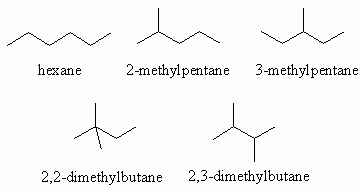| |
 For hexane the relative yields of the 3 possible chlorination
products are:
For hexane the relative yields of the 3 possible chlorination
products are:
% 1-chlorohexane = 100 x (6 x 1) / (6 x 1
+ 8 x 3.9) = 100 x 6 / 37.2 = 16.1 %
% 2-chlorohexane = 100 x (4 x 3.9) / (6 x 1 + 8 x 3.9) = 100 x 15.6 /
21.6 = 41.9 %
% 3-chlorohexane = 100 x (4 x 3.9) / (6 x 1 + 8 x 3.9) = 100 x 15.6 /
21.6 = 41.9 %
For 2,2-dimethylbutane the relative yields of the 3 possible
chlorination products are:
% 1-chloro-2,2-dimethylbutane = 100 x (9
x 1) / (12 x 1 + 2 x 3.9) = 100 x 9 / 19.8 = 45.5
%
% 3-chloro-2,2-dimethylbutane = 100 x (2 x 3.9) / (12 x 1 + 2 x 3.9) =
100 x 7.8 / 19.8 = 39.4 %
% 1-chloro-3,3-dimethylbutane = 100 x (3 x 1) / (12 x 1 + 2 x 3.9) = 100
x 3 / 19.8 = 15.1 %
Hence the isomer must be 2,2-dimethylbutane.
Note we could also have concluded
this without doing the calculation if we realised that the yields of 2-chloro-
and 3-chlorohexane would have to be the same since each arises from the
substitution of 1 of 4 2o H atoms.
One of the important issues
to emerge is that 2 H atoms can be of different types even if they are both
1o / 2o / 3o |
